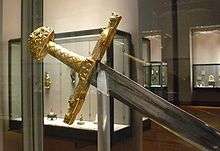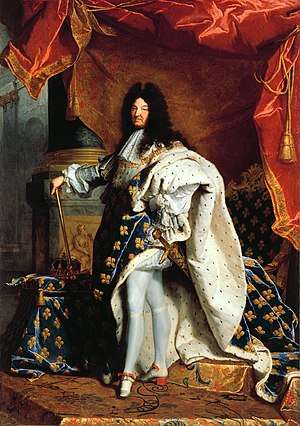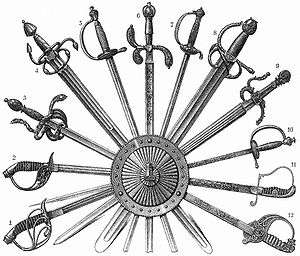Joyeuse
In legend, Joyeuse (pronounced [ʒwaˈjøz]; Old French: Joiuse) was the sword wielded by Charlemagne as his personal weapon. The name means "joyous". A sword identified as Joyeuse was used in French royal coronation ceremonies since the 13th century, and is now kept at the Louvre museum.

In legend

Some legends claim Joyeuse was forged to contain the Lance of Longinus within its pommel; others say the blade was smithed from the same materials as Roland's Durendal and Ogier's Curtana.[1][2]
The 11th century Song of Roland describes the sword:
Si ad vestut sun blanc osberc sasfret,
Laciet sun elme, ki est a or gemmet,
Ceinte Joiuse, unches ne fut sa per,
Ki cascun jur muet.XXX. clartez.
"[Charlemagne] was wearing his fine white coat of mail and his helmet with gold-studded stones; by his side hung Joyeuse, and never was there a sword to match it; its colour changed thirty times a day."
Some seven hundred years later, Bulfinch's Mythology described Charlemagne using Joyeuse to behead the Saracen commander Corsuble as well as to knight his comrade Ogier the Dane.
The town of Joyeuse, in Ardèche, is supposedly named after the sword: Joyeuse was allegedly lost in a battle and retrieved by one of the knights of Charlemagne; to thank him, Charlemagne granted him an appanage named Joyeuse.
Baligant, a general of the Saracens in The Song of Roland, named his sword Précieuse, in order not to seem inferior to Charlemagne.
Coronation sword of the French kings

A sword identified with Charlemagne's Joyeuse was carried in front of the Coronation processionals for French kings, for the first time in 1270 (Philip III), and for the last time in 1824 (Charles X). The sword was kept in the Saint Denis Basilica since at least 1505, and it was moved to the Louvre in 1793.
This Joyeuse as preserved today is a composite of various parts added over the centuries of use as coronation sword. But at the core, it consists of a medieval blade of Oakeshott type XII, mostly dated to about the 10th century. Martin Conway argued the blade might date to the early 9th century, opening the possibility that it was indeed the sword of Charlemagne, while Guy Laking dated it to the early 13th century. Some authors have even argued that the medieval blade may have been replaced by a modern replica in 1804 when the sword was prepared for the coronation of Napoleon Bonaparte.
The Louvre's official website dates the pommel to the 10th to 11th centuries, the crossguard to the 12th and the scabbard to the 13th century.[3]
The overall height of the sword is 105 cm (41 1⁄3 in) with the blade portion making up 82.8 cm (32 3⁄5 in) of that. It is 4.5 cm (1.77 in) wide at the base, and 2.2 cm (0.87 in) thick. Its total weight is 1.630 kg (3.59 pounds).
References
- Bullfinch's Mythology, Legends of Charlemagne, Chapter 24
- Santosuosso, Antonio (2004). Barbarians, Marauders, and Infidels: The Ways of Medieval Warfare. New York, NY: MJF Books. p. 134. ISBN 978-1-56731-891-3.
- Coronation sword and scabbard of the Kings of France on the Official Website of the Louvre.
